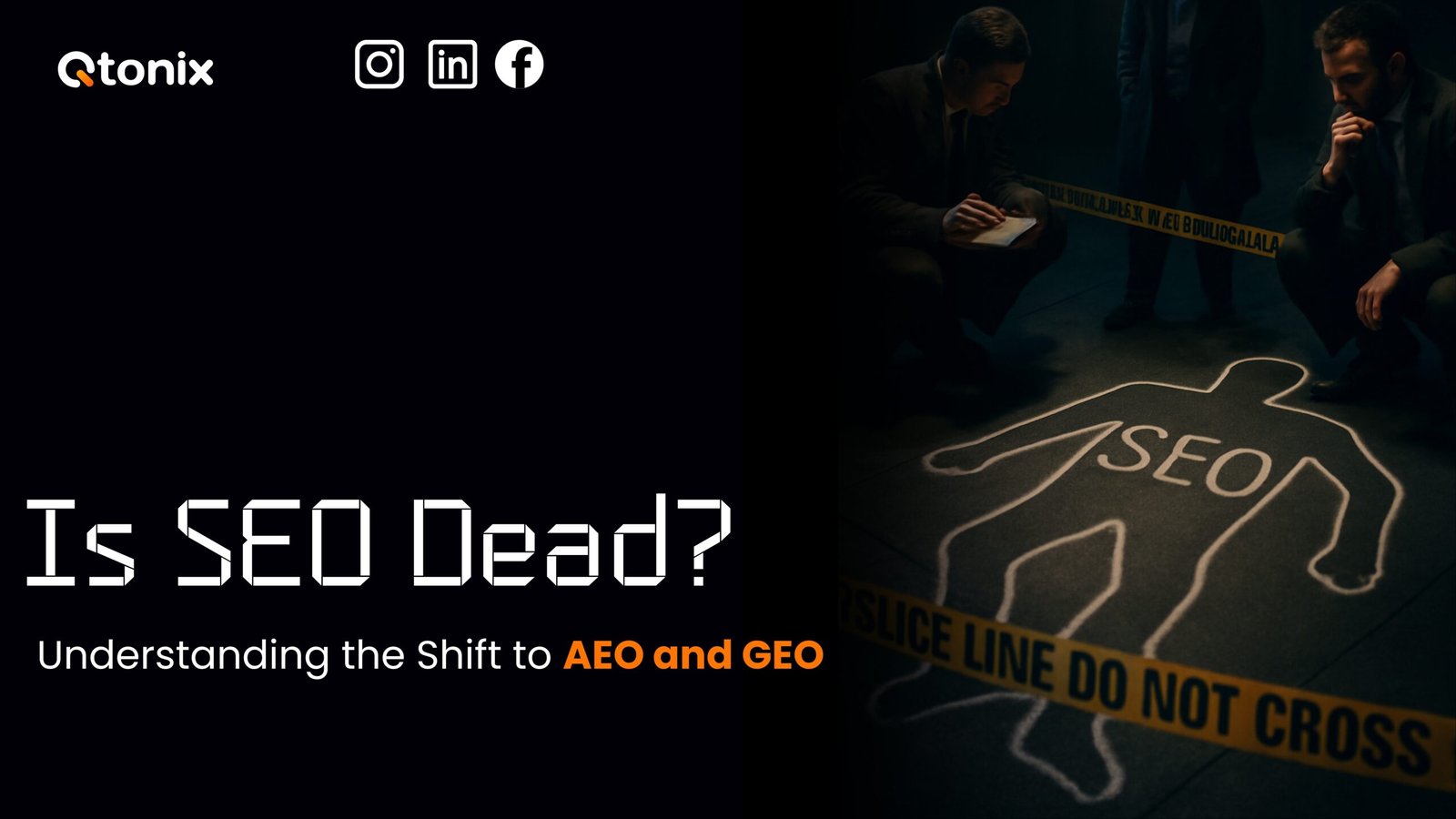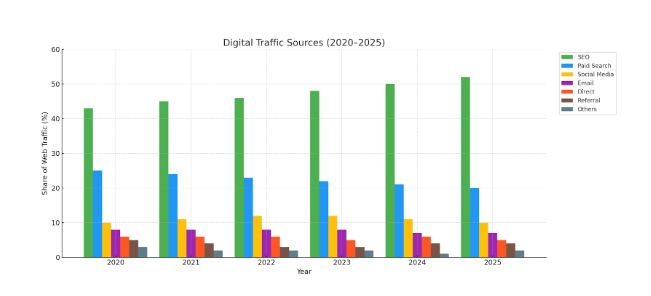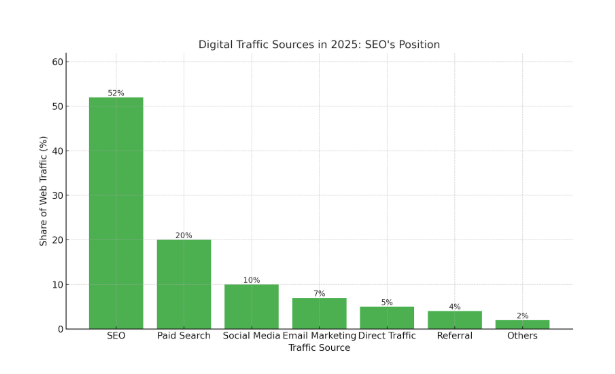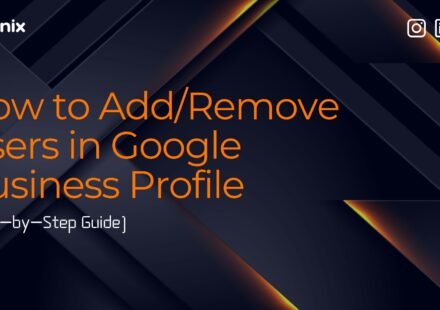Is SEO Dead? Understanding the Shift to AEO and GEO

Research indicates that Google remains the leading search engine, accounting for 64% of web traffic in the United States.
It still owns the web, no doubt.
However, SEO is no longer what it used to be. A new era of information discovery has emerged.
Did you know? Google now starts rolling out more than 12 algorithm updates every day, while platforms like Amazon, TikTok, and ChatGPT are rapidly transforming the search landscape.
Let’s be frank: traditional SEO strategies are no longer the best options.
To succeed, you have to change your ways.
In 2025, search engine optimization goes beyond Google. It has become search everywhere optimization.
So, is SEO dead? Not exactly!
But it’s undergoing a significant transformation.
Let’s dive into the data to verify where SEO stands in 2025.
Key Takeaways
- SEO continues to drive more than 52% of website traffic, making it a crucial part of any digital strategy.
- Google’s commitment to user experience, including mobile optimization and site speed, means that SEO remains crucial for ranking.
- As SEO algorithms change and users seek alternatives to find ideas and relevant information, such as GenAI and social media platforms, search engine optimization is evolving into search everywhere optimization.
- Content that matches niche targeting and search intent continues to play a significant role in influencing organic rankings and driving business expansion.
- Optimizing content only for search engines is no longer enough. Every marketer must continually adapt to incorporate the latest trends, such as voice search, AI, and personalization.
Where SEO Stands Today?
Currently, Google processes roughly 8.5 billion searches each day. It means people search nearly 99,000 times per second. Although Google never discloses the official data on search volume, these estimates are commonly referenced by industry professionals.
If you consider the last 5 years’ data, you will find that SEO is consistently emerging as the dominant channel. It rapidly grows from 43% in 2020 to a commanding 52% in 2025. This rise clearly shows the key importance of organic visibility and user trust in search engines.

Moreover, this dominant share also emphasizes the importance of organic search in driving user engagement and online visibility. In comparison to other channels, such as paid search, social media, and email marketing, SEO outperforms in both reach and reliability.

SEO’s top position directly reflects a shift in user behavior toward search-driven and trusted sources rather than paid experiences. As online competition intensifies, businesses that prioritize search engine optimization are more likely to attract sustainable traffic and maintain a competitive edge in the digital landscape.
SEO vs AEO
Answer engine optimization (AEO) is a rising star of the digital era.
With the massive adoption of AI tools like Google Bard and ChatGPT, the rapid evolution of voice assistants like Alexa, and the use of GenAI in search, AEO has become more critical than ever.
If you’re not adding AEO marketing techniques to your content, you may fall behind the competition.
Our team at Qtonix recently surveyed a group of digital marketing experts to gain insight into their approach to optimizing content for chatbot responses. When we asked about their plans, 32% said they already have a unique strategy in place, while nearly 40% are currently creating one. Only 19% admitted they don’t have a plan yet, but it’s on their business roadmap for 2025 and beyond.
Why is AEO so demanding?
Many people think AEO is a subset of SEO, and it’s true.
It aims to deliver high-quality and relevant content to users, but in different ways.
SEO leverages several factors, including data markups, keywords, site structure, and internal and external links, to determine how webpages are ranked in search results. Its primary goal is to deliver relevant results aligned with user intent and search queries.
AEO, on the other hand, while leveraging similar elements as SEO, directly focuses on answering the user’s queries.
Then, how does AEO work?
AEO primarily works through the optimization of digital content to ensure it is easily discoverable, understandable, and delivered as a direct response by AI-driven systems, such as voice assistants, chatbots, and search engine features. Let’s have a look at how AEO helps:
- Voice Search Optimization: Optimize your content to reflect natural and conversational queries, using question-based headings and long-tail keywords to improve its compatibility with AI-driven voice search and chatbot responses.
- Schema Tag Implementation: A schema tag refers to adding structured data to your website, enabling search engines to understand your site’s content better. By tagging elements like events, reviews, or FAQs, your information will appear prominently in search results. It will result in improved visibility and better search engine rankings.
- Featured Snippet Management: Structure your content using tables, lists, and concise paragraphs to help search engines easily find key information and boost the chances of being featured in snippets.
SEO vs GEO
SEO vs GEO isn’t just a buzzword battle; it marks a significant shift that’s already impacting your web traffic, often without you even noticing.
Unlike traditional SEO, Generative Engine Optimization (GEO) solely focuses on getting your content recognized, cited, and featured directly within AI-driven responses.
However, the truth is that your competitors who are aware of this shift are already adapting & gaining an edge, while you may still be investing in outdated SEO strategies with shrinking returns.
GEO boosts your online visibility in AI platforms like Google AI Overviews and ChatGPT. Here’s how it works:
- Content Ingestion: AI-driven systems consistently take in web content, either during their initial training or through real-time information retrieval.
- Knowledge Extraction: Artificial intelligence finds important facts, relationships, and entities within your content.
- Relevance Assessment: When you search for any query, the AI will find the sources that deliver trustworthy and relevant information.
SEO vs AEO vs GEO
Let’s examine the comparative table below, which highlights the key differences and focus areas of SEO, AEO, and GEO.
| Objectives | SEO | AEO | GEO |
| Focus areas | Rank websites in search engine results page (SERP) | Deliver concise and direct answers to user queries | Manage content to be included in AI-driven responses (e.g., Gemini, ChatGPT) |
| User intent | Navigational, transactional, and informational | Informational and question-based queries | Contextual and conversational queries |
| Targeted platforms | Search engines (e.g., Google, Bing) | Featured snippets, People Also Ask, voice assistants | AI assistants, generative search (Google SGE), LLM-based chatbots |
| Content Format | Keyword-rich blogs, web pages, product pages | Structured answers, FAQs, how-tos, schema markup | Natural language, entity-focused, authoritative content |
| Optimization Techniques | Keywords, backlinks, metadata, site structure | Structured data, question answering, concise paragraphs | Entity linking, authoritative sources, schema, AI-readable formatting |
| Measurement Metrics | SERP rankings, organic traffic, CTR | Featured snippet presence, voice search visibility | Inclusion in AI responses, mentions by LLMs, traffic from AI platforms |
| Tools Involved | Google Search Console, Ahrefs, SEMrush | Answer The Public, AlsoAsked, schema validators | ChatGPT, Perplexity, Google SGE data, LLM analytics tools |
What’s the Conclusion?
Honestly, you will need all three.
SEO is still alive, but it’s not the only one in town. AEO and GEO are rapidly transforming how users discover, trust, and engage with online content.
Any adaptation always takes time. Combining them can be a wise investment if you are planning to future-proof your entire content strategy.
Need help? Let our experts audit your webpages for SEO, AEO, and GEO opportunities.
FAQs
Not necessarily! While schema markup and technical SEO need some knowledge, most AEO and GEO practices revolve around:
- Writing in a conversational and clear
- Creating content with lists, questions, and direct answers
- Developing trust and authority in your niche
- For AEO: Semrush, AnswerThePublic, Frase, Google’s People Also Ask
- For GEO: ChatGPT, Google SGE, and Perplexity.ai
- For Both: Google Search Console, Clearscope, Screaming Frog, and schema generators
Yes. Effective content in 2025 is layered. A well-structured content should include keywords (SEO), schema markup, FAQs (AEO), and fact-rich insights (GEO), all in one.
E-E-A-T means Experience, Expertise, Authoritativeness, and Trust. It’s essential because search engines and artificial intelligence prioritize credible sources. E-E-A-T focuses on delivering relevant and trustworthy information to users, especially in the context of AI-driven search.
Schema allows machines to understand your content precisely. For AEO, it improves your chances of showing in knowledge panels, voice responses, and featured snippets. For GEO, it enables AI tools to extract structured data, such as names, prices, dates, reviews, and FAQs. It makes your content more AI-friendly.
Written by Adam Gibbs
Adam is a skilled SEO content expert with a proven track record of crafting high-quality, keyword-rich content that drives traffic, engages readers, and ranks on search engines. With 10+ years of experience in digital marketing and content strategy, Adam specializes in creating blog posts, website copy, and marketing materials tailored to both audience needs and SEO best practices.
Related Posts
A Complete Guide to Adding and Managing Users in Google Analytics 4
How to Add a User to Google Ads: Standard vs. Admin Access Explained
- All Posts
- SEO

Table of Contents Book Intro Call Case Studies Share: Related Guides: Related Posts Step-by-Step Tutorial: How to Share Google Tag...

Table of Contents Book Intro Call Case Studies Share: Related Guides: Related Posts Step-by-Step Tutorial: How to Share Google Tag...

Table of Contents Book Intro Call Case Studies Share: Related Guides: Related Posts Step-by-Step Tutorial: How to Share Google Tag...

Table of Contents Book Intro Call Case Studies Share: Related Guides: Related Posts Step-by-Step Tutorial: How to Share Google Tag...





